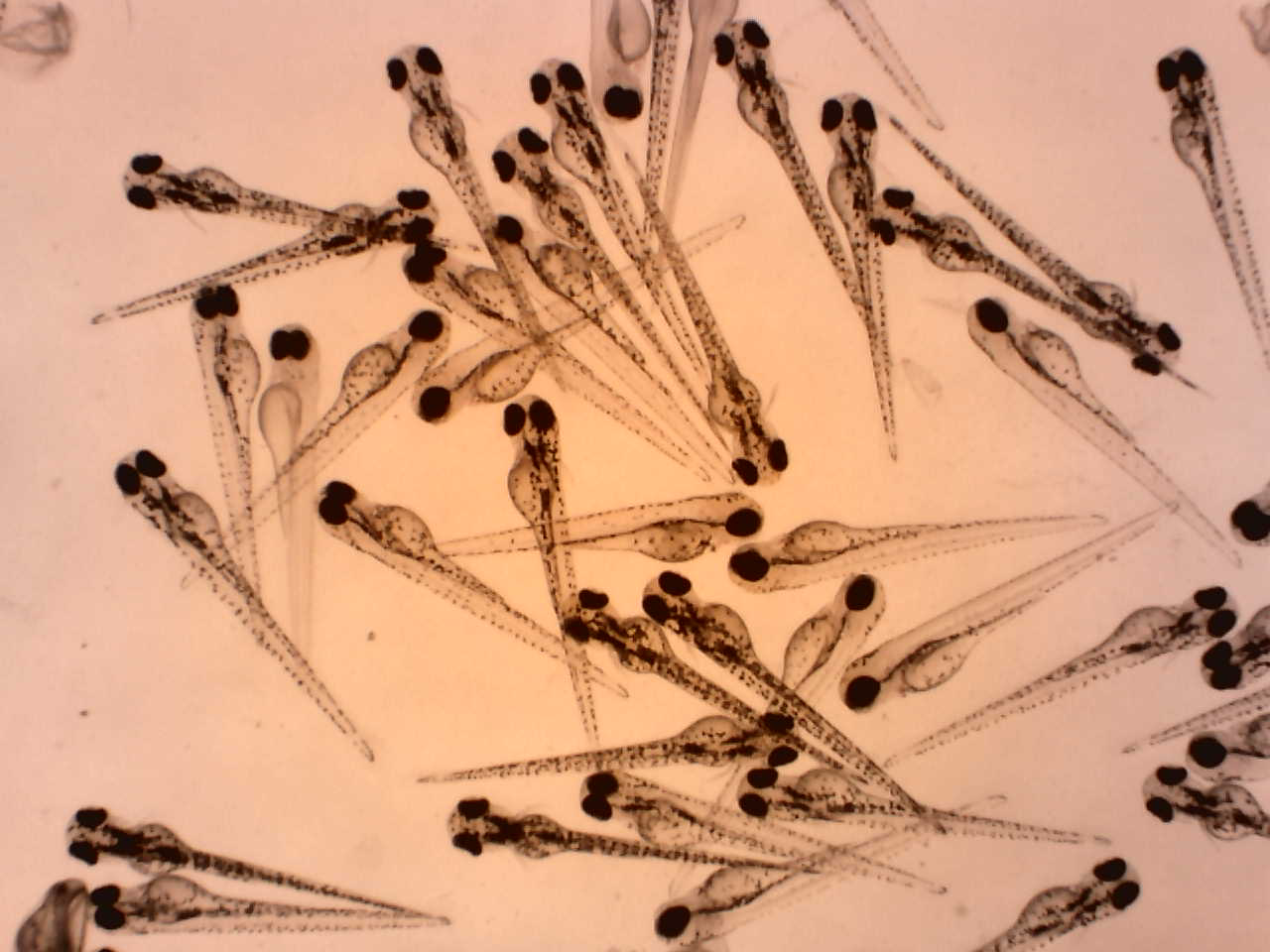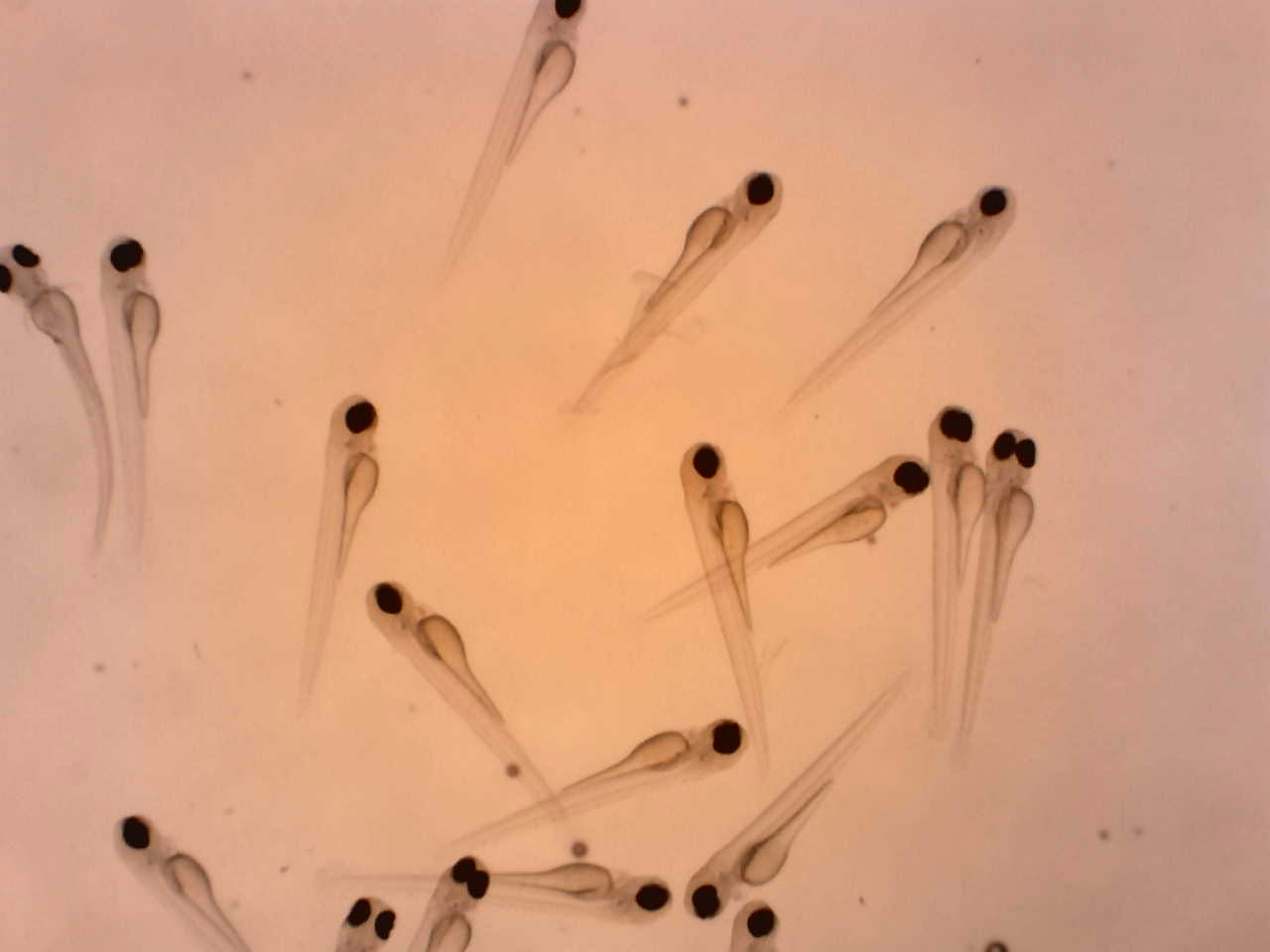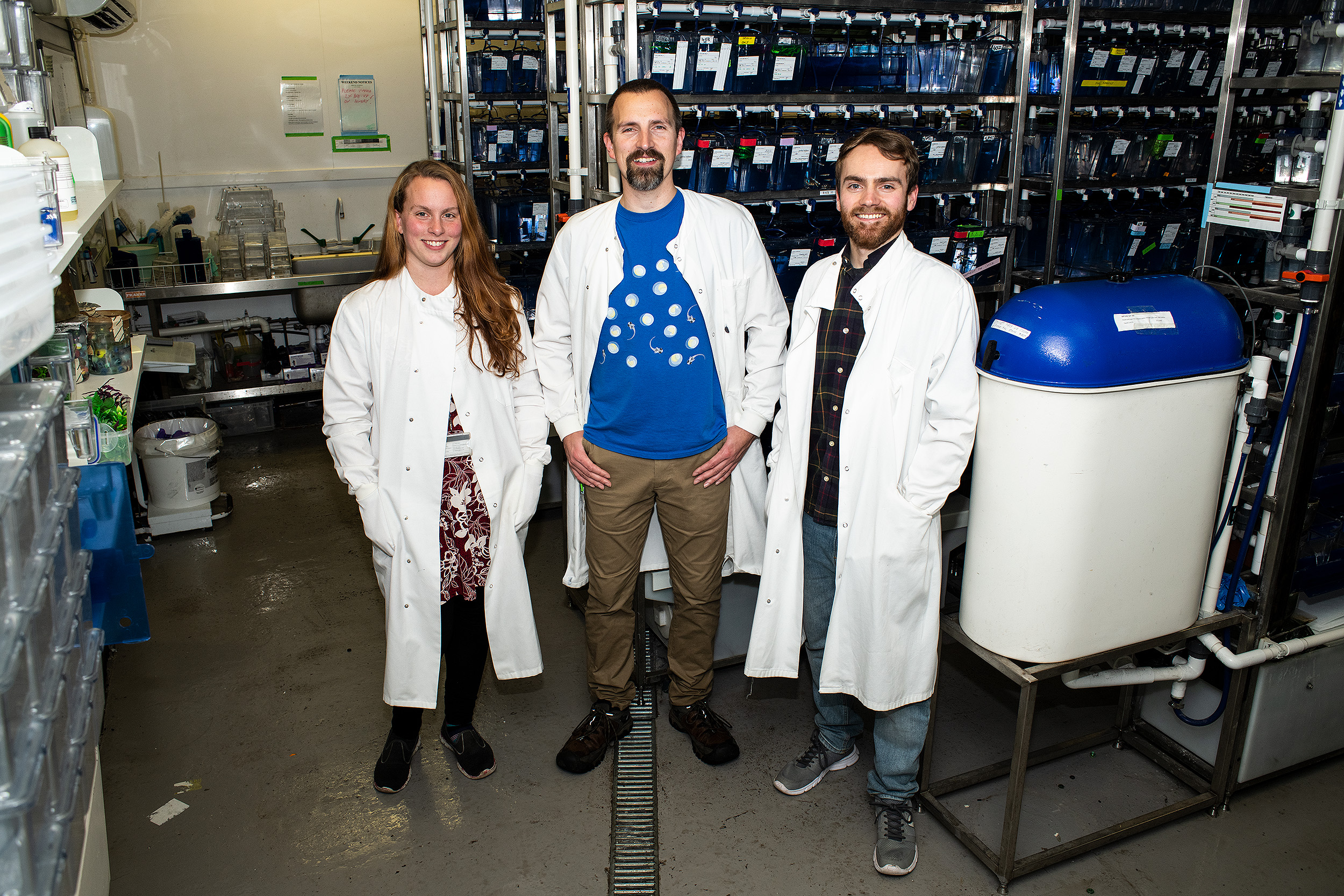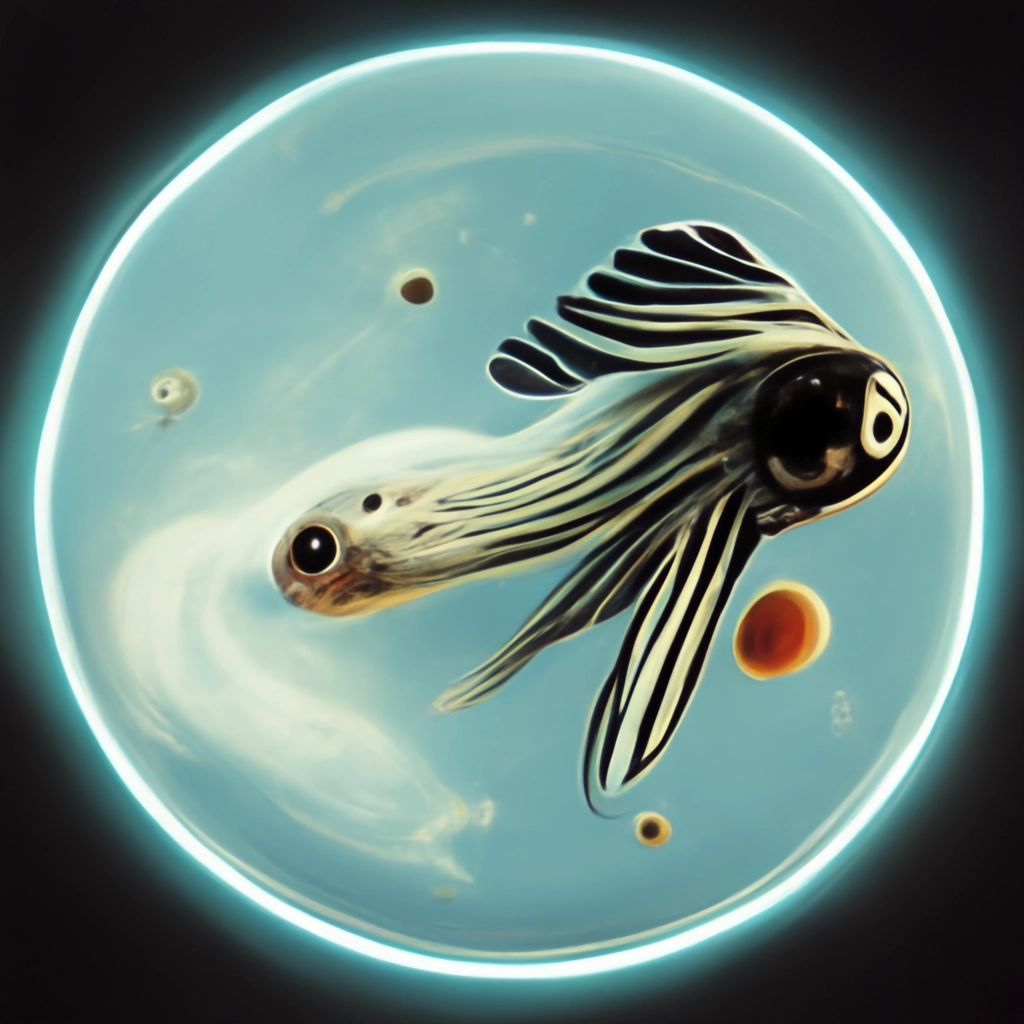A day in the life of a fish in research
As it is #FishInResearch week, I present a day in the life of a fish in research.
Wild type shoal hanging out in their tank.
9AM sharp the sun bursts into life, almost as if it’s on a digital timer. Thousands of zebrafish are bright eyed for the sudden start. The fact that they lack eyelids might have something to do with this.
Time to mate. Better not miss the window. Amorous advances outwith this time tend to be met with an aggressive no as the larger females chase the smaller males away. The early bird gets the worm while the early fish gets the chance of procreation. The advertisements go out: Sleek yellow bellied male seeks rotund white bellied female. Must have own stripes*.
In most tanks, the females remain unmoved by the courtship quivers as they note the smooth tank floor. In selected tanks, a container of marbles provides more fertile ground for egg laying. The fish approve of the irregular surface that provides crannies for their newly fertilised eggs to fall into and be safe from predation. In this case the predation comes from the parents eating their own eggs. No scientist ever said evolution is perfect.
Soon after the rain of eggs, gloved hands enter the water to remove the container. Unbeknownst to the fish, the eggs are strained out in sieves and collected for raising or microinjection. A single female can produce up to 300 eggs per week, which will be developmental stage matched siblings. A boon to the study of development and genetics, along with their transparency and robustness while developing externally with their own self-contained life support system (the yolk). All that’s required is a drop of water. 300µl will suffice. These embryos can be collected at the 1 cell stage providing hundreds of opportunities for genetic modification, if you can catch the 20 minute window before the cells rapidly divide. Zebrafish are highly amenable to all the standard genetic modification techniques, whether the ever popular CRISPR, transposons, transient mRNA overexpression or venerable techniques such as chemically induced random mutagenesis. While tricky procedures with a low success rate may be insurmountable in mammalian models, it can become viable when you have ready access to hundreds of eggs and the embryos can be screened and selected early in development. A dish of hundreds of embryos can be non-invasively screened under the most basic of fluorescence microscopes in a matter of minutes. A constellation of tiny, beating, 2-chambered, green hearts floating in the darkness, transparent bodies invisible, is a typical sign of success.


3 day old wild type embryos (left) and their more transparent mutant cousins (right), already hatched and capable of swimming.
By 3 days old they can already see, hear, smell and respond to the environment. The video shows them escaping from a potential predator.
The parent fish are oblivious to all of this and unharmed by it, a key advantage of a model organism with external development. After some morning mating, successful or rebuffed, they eagerly await breakfast. As humans move along the rows of tanks, a ripple of excitement passes around the room, in a very real way, as the fish see the excitement of their neighbours and get vicariously worked up. They know people are there and they know people mean food. The myth of the 6 second memory is as untrue for zebrafish as it is for goldfish. Their brains contain 10,000,000 neurons**, which for a 3cm creature, is nothing to be sniffed at (excluding the neurons of the olfactory bulb which benefit from some sniffing but I don’t think we should get into what a sniff is underwater and if it counts as a sniff when you move your nostril relative to the water rather than moving the air relative to your nose). As anticipation builds, a normally 3-dimensional shoal, occupying the full tank volume, form themselves into a nearly 2-dimensional sheet pressing up against the front of the tank, jockeying for position near the feeding holes. After a few false alarms (researchers) the food bringer arrives. Breakfast is artemia, a type of brine shrimp that are the cousins of the pet that has disappointed generations: Sea Monkeys. The artemia jostle and flutter in the water column with the ceaseless, mechanical flapping of their exopods.
Artemia jostling in a drop of salty water. The spheres are unhatched cysts, a type of egg that can stay in suspended animation for decades!
Zebrafish are active predators, using keen sight and smell, to locate, track and devour the artemia in a frenzied competition. Acute vision put to precise use. The motion of their protruding eyes as they track prey is a rich vein of behavioural research. Their eyes are about a third the size of their brains and contain 100,000 retinal ganglion cells each, representing a significant investment as a proportion of their nervous system. The fish are entertained (environmentally enriched) by the hunt for live, mobile food. We’re not sure what the artemia think of this. They might not know what is coming but they can certainly see it coming with their 3 (yes, 3, count ’em) eyes.
Most research is performed on embryos, rather than adult fish, so the morning breeding window is a busy time followed by quiet. The human technicians come and go for a few hours, checking on the parameters of the aquatic world: pH (7.0), conductivity (550µSiemens), total gas pressure (100%) and temperature, a comfortable 28.5°C as befits their (sub)tropical origins. The air temperature, which the fish do not concern themselves with, is a very humid 26°C. This prompts many of the clothed mammals to consider if they should have chosen a research model that lives at a more civilised temperature, such as the Arctic cod or woolly rhino.

The aforementioned sweaty mammals. Charli Corcoran, Cameron Wyatt, Jonathan Smith.
While zebrafish are fairly tolerant of a range of pH and conductivity, zebrafish embryos are particularly sensitive to temperature with the ambient temperature strongly impacting their rate of growth and developmental stage. This means their rate of development can be altered by adjusting the temperature, up or down, which is a handy time travel trick for a variety of experiments. Beyond rate of growth, reducing temperature by only a few degrees can result in permanent reversal of asymmetry in some tissues including brain structures.
Regardless of brain symmetry, all zebrafish brains are anticipating the next feed. The afternoon foodstuff is a deluxe version of the goldfish granules most people will be familiar with. There is no shortage of enquiry into the optimum blend of protein, fats and nutrients extracted from plant or animal sources to achieve ideal growth and fertility. In reality, we let our fish tell us. Food mix is tweaked until our fish are a good size and breeding by 3 months of age, even if they aren’t following the dietary rules as laid down by Big Plankton. The thing is, zebrafish are a heterogenous lot and vary from facility to facility. They don’t tolerate inbreeding as rodents do. While a mouse house might be looking for 20 generations to establish an inbred strain, zebrafish get unhappy after 5 incrosses, requiring frequent outcrossing to stop their gene pool becoming uncomfortably shallow. Somewhat ironic for an animal which happily lives in puddles bordering monoculture rice paddies. Background mutation rate is possibly 200 times higher than that of mammals, potentially a consequence of a reproductive strategy that favours quantity. The zebrafish proffer no opinion on this as the dry feed begins. They have much more important business to attend to. They thrash like tiny piranha as they compete for the food. No amount will satisfy them. If allowed, they will eat until their throats are stuffed with food. Like the fabled greedy dog, they will snap at a morsel of food only to have more pieces fall out of their mouths in the process. Despite their insatiable appetite, zebrafish will ignore mounds of food on the floor of the tank. They are not generally bottom feeders unless the food smells particularly enticing. Redirecting the water inflow to stir up the pellets will suddenly renew their interest in the fallen morsels they have swam past 20 times already. No scientist ever said evolution is perfect. The fish are fed enough to fill their bellies, if not their throats. This is, in theory, between 1 and 4% body weight per day but the fish let us know when they have had a sensible amount. The feeding drops a gear from “frenzy” to “urgent” and then a further gear to “highly interested”. Second helpings are provided for the fish that are growing or getting ready to give eggs, a very resource demanding task given the volume of eggs a single female can produce relative to her body mass. Perhaps due to this onerous demand, the development of embryos into females tends to be favoured in times of plenty. High density housing, scarce food and poor water quality tends to push a shoal into developing more males, and vice versa. The sex of lab zebrafish is inscrutable, anatomically and genetically, for their first 3 weeks of life. This is curious as wild zebrafish sex is dominated by sex determining chromosomes which are readily detected. Why these have been lost in lab strains is a topic of debate. The practical outcome is that we can tweak sex ratios via their environment.
Come evening, human activity increases again as marbles are deposited in group tanks and males and females are paired in mating tanks in the hopes of eggs tomorrow. Then the human disturbances trail off, leaving the fish in their own world. Occasional bickering. Hiding behind some plants. Snatching up a piece of food caught in the water current. Finding it was actually poop and spitting it out. The usual. At 11PM the artificial sun goes down, maintaining a 14 hour light to 10 hour dark cycle, convincing the fish that it is always mating season. Tomorrow is another day and it will probably have food in it. Tonight, the zebrafish, which are known to have REM sleep, dream of tomorrow’s food. The artemia are happy to wait.
*Unless it’s one of our pigment mutants who have their stripes turned off to enhance transparency.
**Take these numbers with a very large pinch of aquarium salt (Coral Pro brand, if you can get it) as a search of the literature will give you a wide range of estimates. Also, our fish are particularly smart.***
***Given that zebrafish have 10 million neurons and humans 86 billion, our super-shoal of 10,000 zebrafish is the smartest entity in the facility.
If you are looking for more fishy action you can follow us on Twitter @ModelZebrafish (https://twitter.com/modelzebrafish) and check out our takeover of the Understanding Animal Research Instagram account: https://www.instagram.com/stories/highlights/17868181478804920/

UAR Instagram takeover
As a bonus for reading to the very end, enjoy a zebrafish swimming in orbit. Taken directly from a zebrafish’s recurring dream…possibly.

“Zebrafish in Orbit” – Generated by Cameron Wyatt using Midjourney AI.
(Cameron Wyatt)
(Cameron Wyatt)
(Connor Warnock)
(Charli Corcoran)




1 replies to “A day in the life of a fish in research”